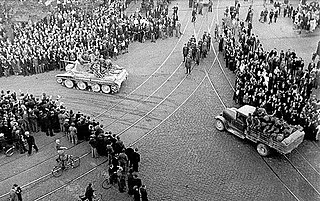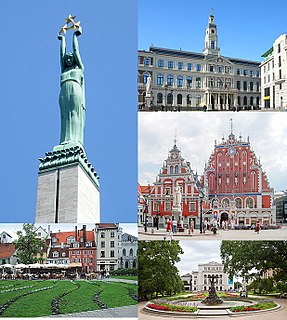
The history of Latvia began around 9000 BC with the end of the last glacial period in northern Europe. Ancient Baltic peoples arrived in the area during the second millennium BC, and four distinct tribal realms in Latvia's territory were identifiable towards the end of the first millennium AD. Latvia's principal river Daugava, was at the head of an important trade route from the Baltic region through Russia into southern Europe and the Middle East that was used by the Vikings and later Nordic and German traders.

The Singing Revolution is a commonly used name for events between 1987 and 1991 that led to the restoration of the independence of Estonia, Latvia and Lithuania. The term was coined by an Estonian activist and artist, Heinz Valk, in an article published a week after the 10–11 June 1988, spontaneous mass evening singing demonstrations at the Tallinn Song Festival Grounds.

The Latvian Soviet Socialist Republic, also known as Soviet Latvia or Latvia, was a republic of the Soviet Union.

OMON is a system of special police units of Federal Police within the National Guard of Russia, and previously Soviet and Russian Ministries of Internal Affairs. It was created as the special forces of the Soviet Militsiya in 1988, and then played major roles in several armed conflicts during and following the dissolution of the Soviet Union.
Vladimir Yurievich Antyufeyev, also known under the assumed name Vadim Shevtsov or Vladimir Shevtsov is a former Soviet OMON police officer who was one of organizers of the attempt to overthrow the Latvian government in 1991. As "Vadim Shevtsov", he was later the head of the Ministry of State Security of Moldova's pro-Moscow separatist state of Transnistria between 1992 and 2012. He is a Russian and Transnistrian citizen and was for many years wanted by the law enforcement agencies of Latvia and Moldova. He is no longer wanted by the Latvians however due to their statute of limitations on the type of crime he was alleged to have committed. In July 2014, Antyufeyev became one of leaders of Ukraine's pro-Russia secessionist rebels.

The January Events took place in Lithuania between 11 and 13 January 1991 in the aftermath of the Act of the Re-Establishment of the State of Lithuania. As a result of Soviet military actions, 14 civilians were killed and 702 were injured. The events were centered in its capital, Vilnius, along with related actions in its suburbs and in the cities of Alytus, Šiauliai, Varėna, and Kaunas.
Several Soviet OMON assaults on Lithuanian border posts occurred in 1991, after Lithuania declared its independence from the Soviet Union on 11 March 1990. As a Soviet republic, the Lithuanian SSR did not have a state border with customs or checkpoints. The newly declared Republic of Lithuania began establishing the State Border Guard Service, before it was internationally recognized on 27 August 1991 by the states of the European Community. These posts also became a symbol of its struggle for independence. The Soviet government viewed the customs posts as illegal and sent the OMON troops against the posts, especially those along the eastern border with Belarus. The unarmed custom officers and policemen were harassed, beaten or killed, their cars were stolen or bombed, the posts were burned down or wrecked, and work of the checkpoints was otherwise disrupted. Two of the incidents resulted in the deaths of eight Lithuanian citizens. In total, about 60 officers were attacked and injured, and 23 border posts were burned or destroyed.
A large number of Latvians resisted the occupation of Latvia by Nazi Germany. The Latvian resistance movement was divided between the pro-independence units under the Latvian Central Council and the pro-Soviet units under the Central Staff of the Partisan Movement in Moscow. Around 22,000 deserted both from the Red Army and German Army during 1943–45 in Latvia. Daugavpils was the scene of fierce Jewish resistance during the Holocaust. Many local Latvians were actively involved in the resistance movement against the ethnic policies of the German occupation regime. Žanis Lipke risked his life to save more than 50 Jews. 134 Latvians later have been honored with the title Righteous Among the Nations.

The Act of the Re-Establishment of the State of Lithuania or Act of March 11 was an independence declaration by the Lithuanian Soviet Socialist Republic adopted on March 11, 1990, signed by all members of the Supreme Council of the Republic of Lithuania led by Sąjūdis. The act emphasized restoration and legal continuity of the interwar-period Lithuania, which was occupied by the USSR and lost independence in June 1940. It was the first time that an occupied state declared independence from the dissolving Soviet Union.

The Barricades were a series of confrontations between the Republic of Latvia and the Union of Soviet Socialist Republics in January 1991 which took place mainly in Riga. The events are named for the popular effort of building and protecting barricades from 13 January until about 27 January. Latvia, which had declared restoration of independence from the Soviet Union a year earlier, anticipated that Soviet Union might attempt to regain control over the country by force. After attacks by the Soviet OMON on Riga in early January, the government called on people to build barricades for protection of possible targets. Six people were killed in further attacks, several were wounded in shootings or beaten by OMON. Most victims were shot during the Soviet attack on the Latvian Ministry of the Interior on January 20. One other person died in a building accident reinforcing the barricades. Casualties among Soviet loyalists are considered likely, but the exact number remains unknown. A total of 15,611 people have registered as having been participants of the Barricades, but other data suggests that more than 32,000 Latvians took part.
Anatols Dinbergs was one of the preeminent career diplomats of Latvia. He entered service in Latvia's Foreign Ministry in 1932. Dinbergs remained abroad when the Soviet Union occupied Latvia, serving in the Latvian Legation in Washington, D.C., after World War II ended. Dinbergs assumed the highest diplomatic post, that of chargé d'affaires, in 1970 and represented Latvia's sovereign interests in exile until Latvia reestablished its independence in 1991. As head of the Latvian diplomatic service abroad, Dinbergs was appointed Latvia's first ambassador to the United Nations and subsequently Latvia's first ambassador to the United States. After retirement, he served as Counselor to the Latvian Embassy in Washington, D.C., until his death in 1993.

The Declaration "On the Restoration of Independence of the Republic of Latvia" was adopted on 4 May 1990, by the Supreme Soviet of the Latvian SSR. The Declaration stated that, although Latvia had de facto lost its independence in 1940, when it was annexed by the Soviet Union, the country had de jure remained a sovereign country as the annexation had been unconstitutional and against the will of the people of Latvia. Therefore it resolved that the Molotov–Ribbentrop Pact and the Soviet occupation of Latvia in 1940 were illegal, and annulled the declaration on the accession of Latvia to the Soviet Union of 21 July 1940, re-instituted the Constitution of Latvia of 1922, which was thereupon partly suspended, and set a period of transition to de facto independence, which would end upon the first session of Saeima. It also ruled that during the transitional period the Constitution of the Latvian SSR and other laws would remain applicable as long as they did not contradict articles 1, 2, 3, and 6 of the Constitution of Latvia, which were reinforced by the declaration. It was provided that a committee to elaborate a new edition of the Constitution of Latvia should be created. Social, economic, cultural, and political rights were granted to citizens and residents of Latvia in accordance with international human rights. The declaration also stated that Latvia would form its relationship with the Soviet Union on the basis of the Latvian–Soviet Peace Treaty of 1920, in which the Soviet Union had recognized the independence of Latvia as inviolable "for all future time". The 4th of May is a national holiday in Latvia.

Relevant events began regarding the Baltic states and the Soviet Union when, following Bolshevist Russia's conflict with the Baltic states—Lithuania, Latvia and Estonia—several peace treaties were signed with Russia and its successor, the Soviet Union. In the late 1920s and early 1930s, the Soviet Union and all three Baltic States further signed non-aggression treaties. The Soviet Union also confirmed that it would adhere to the Kellogg–Briand Pact with regard to its neighbors, including Estonia and Latvia, and entered into a convention defining "aggression" that included all three Baltic countries.
The Sovietization of the Baltic states refers to the sovietization of all spheres of life in Estonia, Latvia and Lithuania when they were under control of the Soviet Union. The first period deals with the occupation from June 1940 to July 1941 when the German occupation began. The second period covers 1944 when the Soviet forces pushed the German out, until 1991 when independence was declared.
The Latvian Central Council (LCC) was the pro-independence Latvian resistance movement during World War II from 1943 onwards. The LCC consisted of members from across the spectrum of former leading Latvian politicians and aimed to be the governing body after the war. Its military units were an alternative to the Soviet partisans also operating in Latvia.

This Baltic states were under Soviet rule from the end of World War II in 1945, from Sovietization onwards until independence was regained in 1991. The Baltic states were occupied and annexed, becoming the Soviet socialist republics of Estonia, Latvia and Lithuania. After their annexation by Nazi Germany, the USSR reoccupied the Baltic territories in 1944 and maintained control there until the Baltic states regained their independence nearly 50 years later in the aftermath of the Soviet coup of 1991.
















